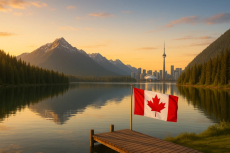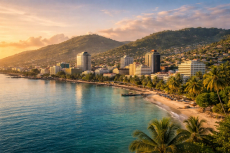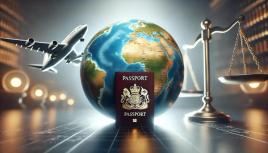
Blogs • January 9, 2026 • 17 Min
Top Asian Countries for Second Residency in 2026
If you’ve been paying attention to global mobility trends, you’ll notice more people are looking at Asia for second residency in 2026. The interest isn’t coming from one group. Retirees, entrepreneurs, remote workers, globally mobile families, and investors are all paying attention to the region for different reasons. Some see Asia as a place to run a business or manage taxes more efficiently. Others want a warm and affordable place to retire. And many want the legal right to live somewhere else if circumstances change closer to home. If you’re evaluating second residency seriously, Asia has become part of that discussion for a reason. Before we explore the strongest options for 2026, it helps to understand why the region is attracting this level of interest. Why People Are Choosing Residency in Asia in 2026 Asia’s appeal comes from a mix of economic growth, lifestyle benefits, and residency pathways that do not force a passport change. Different groups are drawn to different features, but the end result is the same: more long-term residents across the region. Below are the main reasons driving this trend. Economic opportunities Asia’s economic influence has been growing for years. Cities like Singapore, Tokyo, Seoul, and Jakarta host major finance, tech, manufacturing, and logistics industries. That creates opportunities for entrepreneurs, founders, and professionals who want to operate closer to these markets rather than visiting on short visas. Residency supports this by allowing longer stays, access to local banking, and the ability to build a sustained relationship with the region. Lifestyle and affordability Southeast Asia has long attracted retirees and long-stay travelers for its warm climate, medical facilities, and daily affordability. In recent years, residency programs have made it easier to stay legally without the uncertainty of constant visa renewals. Countries like Thailand, Malaysia, and the Philippines offer long-stay frameworks that appeal to retirees and remote workers looking for a slower, more affordable pace of life. Tax and financial planning considerations Some Asian countries offer tax systems that appeal to globally mobile professionals. Territorial taxation, for example, can reduce the tax burden on foreign-sourced income under certain conditions. Low or zero personal income tax models exist as well, and residency is often a prerequisite for accessing those frameworks. This explains why business owners and investors sometimes evaluate Asian residency as part of their financial planning rather than pure immigration. Stability and flexibility A second residency provides flexibility without requiring someone to abandon their current citizenship. Many applicants see value in having a legal alternative residence if conditions change in their home country. Asian residency fits this purpose well because programs tend to focus on long-term stay rather than rapid naturalization. The result is a stable presence in another jurisdiction without complex passport considerations. What Asian Residency Actually Means (and How It Works) Residency in Asia gives a foreign national the legal right to remain in a country beyond the limits of a short-term or tourist visa. It typically comes with a residence card or long-stay visa, and in several cases allows family members to join. Unlike citizenship, Asian residency does not grant a passport or voting rights. It grants the legal status required to live, rent property, open local bank accounts, and access healthcare or education under local rules. Some programs also permit business activity or employment, depending on the visa type. To understand how this works, it helps to look at the actual structures governments use, because these shape eligibility and long-term outcomes. Investor and Business Residency This category is based on capital deployment or active business activity, not retirement or tourism. The requirements are specific and codified. Examples: Singapore – Global Investor Programme (GIP) Applicants invest SGD 10–25 million into a new or existing Singapore-based business, or into a GIP-approved fund. Successful applicants receive Permanent Residency, not just a visa. Japan – Business Manager Visa Requires establishing and running a local company with at least JPY 5 million (~$33,000) in capital, plus a physical office lease. Visa renewals depend on business activity and revenue. South Korea – D-8 Investor Visa Requires investment into a Korean company. The minimum capital varies by business type, but typical thresholds range from KRW 100 million to KRW 300 million (≈ $75,000–225,000). Long-term renewal can lead to permanent residency (F-5) after multi-year residence. These pathways attract entrepreneurs and investors who want access to Asian markets, not retirees or passive residents. Long-Stay and Retirement Residency These models are for people who want to live long-term without running a business. Requirements focus on financial capability, deposits, or membership fees. Examples: Thailand – Long-Term Resident Visa (LTR) A 10-year visa for retirees, remote workers, and investors. Retiree applicants must show minimum of $80,000 annual income or a mix of savings + income. Digital professionals must meet salary and remote employer criteria. Malaysia – Malaysia My Second Home (MM2H) Requires fixed deposits in Malaysian banks and proof of offshore income. The deposit amount varies by state (e.g., ~RM 150,000–300,000). Visa validity is typically 5–10 years with renewals. Philippines – Special Resident Retiree’s Visa (SRRV) Requires a bank deposit of $10,000–50,000 depending on age and pension status. The deposit can be used for real estate or long-term lease. SRRV holders get indefinite stay with multiple-entry status. These programs appeal to retirees, remote workers, and long-stay residents who want stability without employment bureaucracy. Capital or Real Estate Residency This model is similar to “Golden Visas” seen elsewhere. Applicants make large financial commitments in exchange for multi-year residency. Example: Indonesia – Golden Visa Offers 5–10 year residency for foreign nationals who invest in local companies, government bonds, or establish corporate entities. Minimum thresholds range from $350,000 to $700,000 depending on category. In this case, residency is tied to capital rather than employment or retirement status. Work and Employer-Sponsored Residency Several Asian countries also grant residency through professional employment, which is common among expats. Examples: Japan – Highly Skilled Professional Visa Uses a points system where education, salary, and work experience contribute. Leads to faster permanent residency compared to standard work visas. South Korea – E-series Work Visas Engineers, teachers, researchers, and professionals can secure multi-year residence with employer sponsorship. These are not “programs” in the investor sense, but they are legitimate residency routes commonly used by foreign nationals in Asia. Does Residency Lead to Citizenship in Asia? Only a few Asian jurisdictions offer a structured pathway: Singapore: PR holders may apply for citizenship after several years of residence and economic contribution. Dual citizenship is not permitted. Japan: Naturalization requires continuous residence (usually 5+ years), financial stability, and language readiness. Dual citizenship is restricted. South Korea: Offers naturalization through residence (F-5 permanent residents), though exams and integration criteria apply. Limited tolerance for dual citizenship. Most Southeast Asian retirement or long-stay visas do not lead to citizenship. The Countries People Are Choosing in 2026 (and Why) Residency in Asia covers different needs. Some countries want active investors and company founders. Others create long-stay frameworks for retirees and remote workers. Below is a clear view of the main options for 2026. Quick Overview Table For Business and Investor Residency These programs expect capital deployment or active business activity. They are used by founders, investors, and professionals who want a legal presence in the market. Singapore Singapore grants residency through the Global Investor Programme (GIP). Applicants invest into a Singapore company or a GIP-approved fund. Investment Range: SGD 10M–SGD 25M (≈ $7.5M–$18.7M) Outcome: You receive Permanent Residency, not a temporary visa. Path to PR / Citizenship: Direct PR via GIP After PR, long-term residents may apply for citizenship (usually requires renouncing other citizenships) Relevance: Singapore fits applicants who want regulatory certainty, financial infrastructure, and recognized long-term status in Southeast Asia. Japan Japan grants residency under the Business Manager Visa, which requires a foreign national to establish and actively operate a Japanese company. Minimum Capital: JPY 5,000,000 (≈ $33,000) Other Conditions: Physical office lease (no virtual offices) Active business operations for renewal Path to PR / Citizenship: Long-term residents meeting continuous residence and integration requirements can apply for Permanent Residency Citizenship remains possible after PR under separate criteria (language, conduct, livelihood) Relevance: Japan suits founders who need supply-chain access, technology collaboration, or a credible East Asian market base. South Korea South Korea issues investor residency through the D-8 Visa when foreign nationals invest into Korean companies. Typical Capital Range: ₩100,000,000–₩300,000,000 (≈ $75,000–$225,000) (Varies by business sector) Pathway: Multi-year renewals can lead to F-5 Permanent Residency with continued business activity Citizenship possible after PR under Korea’s naturalization laws Path to PR / Citizenship: F-5 Permanent Residency is the canonical next step for qualified long-term investors Relevance: Korea fits businesses linked to electronics, manufacturing, and tech, with structured paths to long-term settlement. Indonesia Indonesia offers investor residency under a Golden Visa-style model, granting multi-year visas linked to capital investment or company establishment. Investment Range (Category-Dependent): From $350,000–$700,000 depending on sector and visa term Visa Validity: 5- or 10-year terms Path to PR / Citizenship: Indonesia grants long-term residency, but PR and citizenship require separate procedures with residency duration requirements and local criteria Relevance: Indonesia appeals to those targeting emerging-market growth in manufacturing, logistics, and consumer sectors. Vietnam Vietnam grants long-term stay through Temporary Residence Cards (TRC) for foreign investors and company directors. Capital Requirements: Vary by sector; commonly VND 3B–VND 5B (≈ $120,000–$200,000) for meaningful investor positions Visa Validity: 1–3 years, renewable Path to PR / Citizenship: Permanent Residence Card possible for select long-term professionals Vietnamese citizenship is rare and requires stringent conditions (including renunciation of other citizenships in most cases) Relevance: Vietnam suits founders building export, sourcing, or tech operations rather than passive retirees. For Retirement and Long-Stay Residency These options allow foreign nationals to live long-term without operating local businesses. Requirements focus on financial capability rather than corporate contribution. Malaysia Malaysia offers Malaysia My Second Home (MM2H) with renewable long-term residency. Tier Structure & Deposits: Silver: 10 years | deposit $150,000 (≈ MYR 675,000) Gold: 15 years | deposit $500,000 (≈ MYR 2,250,000) Platinum: 20 years | deposit $1,000,000 (≈ MYR 4,500,000) Property Minimums: Silver: MYR 600,000 (≈ $130,000) Gold: MYR 1,000,000 (≈ $220,000) Platinum: MYR 2,000,000 (≈ $440,000) Path to PR / Citizenship: MM2H is a residency program only Applicants must pursue PR via Malaysia’s general immigration route under separate criteria Relevance: Malaysia fits retirees and long-stay residents who want structured residency with English usage, healthcare access, and manageable costs. Thailand Thailand issues Long-Term Resident Visas (LTR) valid for 10 years across several categories. Retiree Income Thresholds: $80,000/year, or $40,000/year with approved qualifications Additional Condition: Health insurance with $50,000 coverage or equivalent safeguards Path to PR / Citizenship: LTR is not a direct pathway to PR Standard Thai permanent residency and naturalization are separate processes with long residence and additional requirements Relevance: LTR fits retirees and remote workers who want medical infrastructure and stable stay without frequent visa renewals. If you’re a U.S. citizen considering residency in Thailand, you may find our guide useful: How Americans Move to Thailand — Visas, Costs & Requirements Philippines The Special Resident Retiree’s Visa (SRRV) grants indefinite residence with multiple entry. Deposit Requirements (by Category): With pension: $10,000 Without pension: $20,000 Ages 35–49: $50,000 Selected categories allow deposit use toward condominium purchase or long-term lease Path to PR / Citizenship: SRRV is a residency instrument only Naturalization follows the Philippines’ general law (typically ~10 yrs residence) Relevance: The Philippines suits retirees who want an English-speaking environment, private healthcare, and lower daily costs. Cambodia Cambodia offers Retirement Extensions for non-working foreign nationals. Conditions: Proof of retirement status Sufficient funds for living Visa Validity: 12-month renewable extensions Path to PR / Citizenship: Cambodian retirement extensions do not lead to PR Citizenship requires long-term legal residence and formal application Relevance: Cambodia fits retirees wanting minimal bureaucracy and low cost of living rather than long residency pathways. Vietnam (Retirement Context) Vietnam does not offer a dedicated retirement visa. Long-stay retirement is handled through: Long-stay tourist structures Family reunification Business TRC (not suitable for most retirees) Path to PR / Citizenship: TRCs may lead to Permanent Residence Cards in select cases Citizenship remains rare and restricted Relevance: Vietnam does not compete directly with Malaysia, Thailand, or the Philippines in the retirement category. What Are the Benefits of Securing Second Residency in Asia in 2026? Long-Term Legal Stay Without Citizenship Commitments Most Asian residency programs allow foreign nationals to live in the country for extended periods without switching passports or entering naturalization processes. This suits applicants who want a secondary home base or contingency option rather than a permanent identity change. Healthcare and Education Access for Residents and Families Malaysia, Thailand, Singapore, Japan, and South Korea offer established medical systems and private insurance options, while major cities provide international schools. This makes residency usable for households rather than just individuals. Business Presence and Operational Access In markets like Singapore, Japan, South Korea, Vietnam, and Indonesia, residency supports company incorporation, banking, hiring, invoicing, and supply chain entry. This is relevant for founders and investors who need real on-ground presence instead of tourist permissions. Tax and Financial Planning Advantages Some Asian jurisdictions use territorial or low-tax models that benefit globally mobile entrepreneurs, investors, or pensioners. Malaysia applies territorial elements, Singapore maintains competitive tax rates, and certain markets provide structured tax treatment for foreign professionals. Visa Validity That Matches Real Relocation Timelines Rather than short tourist visa cycles, many programs offer genuine stability: Malaysia up to 20 years (MM2H), Thailand 10 years (LTR), Indonesia 5–10 years, the Philippines indefinite (SRRV). Business-focused visas in Japan, Korea, and Vietnam renew through economic activity rather than border runs. Diversification and Contingency Planning Residency offers a legal alternative residence with re-entry rights, family inclusion, and access to essential services. This makes it valuable for applicants from regions facing geopolitical or regulatory volatility who want structured backup options. Compatibility With Remote and Cross-Border Work Residency in Thailand, Malaysia, the Philippines, and Indonesia can accommodate income earned from abroad, including remote employment, pensions, dividends, or business income. This aligns with modern mobility patterns without requiring local employer sponsorship. Family Inclusion Under Dependent Categories Most residency programs allow spouses and minor children to join under dependent status. Thailand’s LTR includes family members, MM2H accommodates full households, and SRRV allows dependents with adjusted deposits. This makes relocation practical for families rather than solo applicants. What Are the Tax Implications of Asian Second Residency? Residency does not always mean tax residency. In Asia, these are treated separately in many jurisdictions, which matters for investors, remote workers, and retirees who earn abroad. Below are the tax considerations that consistently apply to foreign residents. Tax Residency Is Separate from Immigration Residency Several Asian countries allow foreigners to reside without automatically becoming tax residents. Malaysia’s MM2H, Thailand’s LTR, and the Philippines’ SRRV issue residency permits without automatically triggering domestic taxation. Tax residency is typically based on days of presence (often ≥183 days), local income, or permanent home status. Territorial or Modified Tax Systems in Some Jurisdictions Malaysia applies elements of a territorial tax system, meaning foreign-sourced income may remain untaxed unless remitted under specific conditions. Thailand has introduced remittance-based rules for certain foreign income, creating planning opportunities for retirees and remote professionals who earn abroad. Low or Competitive Headline Taxes in Select Markets Singapore maintains competitive corporate and personal tax rates for qualifying income, which is relevant for founders and investors using Singapore for regional business presence. While not “tax havens,” these jurisdictions offer predictable tax treatment and access to treaty networks. Taxation of Local Earnings for Foreign Residents In Japan, South Korea, Vietnam, and Indonesia, foreign residents who earn income locally are generally taxed on that income. For business visas, this is expected: running a company or drawing salary from local operations triggers normal domestic taxation. Double Taxation Agreements and Global Mobility Considerations Several Asian countries maintain double taxation agreements (DTAs) that prevent income from being taxed twice. Singapore, Japan, South Korea, Malaysia, and Thailand have extensive treaty networks, which benefit international professionals, investors, and retirees receiving pensions from abroad. Pensions, Dividends, and Offshore Income Treatment of pensions, dividends, and offshore earnings differs by country: Malaysia and the Philippines generally do not tax foreign pensions. Thailand’s treatment depends on remittance timing under current rules. Singapore taxes income earned in Singapore, not foreign-sourced dividends or capital gains. Foreign residents should understand these distinctions before structuring their relocation. Non-Domicile and Non-Habitual Models Are Emerging While Asia does not follow the European “non-dom” model directly, several countries are exploring remittance-based or foreign-source exemptions for qualifying residents. This reflects broader shifts toward attracting globally mobile individuals rather than only local employees. How Do You Choose the Right Asian Country for Your Second Residency? Choosing where to obtain residency in Asia depends on your intent, budget, family situation, and business footprint. There is no universal “best” program, there are only programs that make sense for specific goals. Below are the factors that matter most when making a decision. Define Your Primary Goal Before You Compare Countries Most applicants fall into one of four intent profiles: Business presence: Singapore, Japan, South Korea, Vietnam, Indonesia Retirement or long-stay: Malaysia, Thailand, Philippines, Cambodia Remote work or flexible relocation: Thailand, Malaysia, Indonesia Contingency / diversification: Malaysia, Thailand, Philippines Matching your intent to the correct residency category prevents misalignment and unnecessary cost. Match Financial Requirements to Your Comfort Zone Programs use different financial models: Capital investment: Singapore, Japan, South Korea, Vietnam, Indonesia Deposits: Malaysia, Philippines Income-based: Thailand (LTR) Minimal financial friction: Cambodia Applicants should compare not just entry cost, but capital lock, liquidity, and renewal expectations. Consider Visa Duration and Renewal Mechanics Visa length is not trivial. It determines how often you must engage with immigration systems. Long cycles (10–20 years): Malaysia, Thailand, Indonesia Indefinite: Philippines (SRRV) Short cycles (1–3 years): Japan, South Korea, Vietnam Annual: Cambodia Longer cycles suit retirees and remote workers. Shorter cycles suit founders managing operations. Evaluate Healthcare, Education, and Infrastructure for Families Applicants relocating with dependents should consider private healthcare access and international schooling: Strong for families: Singapore, Japan, South Korea, Malaysia, Thailand Moderate access: Vietnam, Indonesia Basic: Cambodia This often becomes a decisive factor for applicants with children. Assess Tax Compatibility, Not Just Immigration Rules Applicants frequently overlook tax, which can change the entire relocation calculus. Key distinctions: Territorial / foreign-source-friendly: Malaysia, Thailand (with remittance considerations), Singapore Standard taxation on local earnings: Japan, South Korea, Vietnam, Indonesia Minimal interaction for passive retirees: Philippines, Cambodia Compatibility matters more than “low tax” headlines. Check Pathways to Permanent Residency or Citizenship (If Relevant) If the long-term objective includes PR or citizenship, programs differ significantly: Structured PR path: Singapore, South Korea, Japan Long-stay without PR: Malaysia, Thailand, Philippines, Cambodia Rare citizenship access: Vietnam, Indonesia (strict and limited) Applicants who only want a long-stay base can ignore citizenship entirely. Consider Language and Cultural Integration Requirements Integration expectations vary: Low integration friction: Malaysia, Thailand, Philippines Moderate: Indonesia, Vietnam Structured cultural/language expectations: Japan, South Korea, Singapore (for citizenship) For most applicants, the decision is not “which is the best country,” but: “Do I need a place to live, a place to invest, or a place to operate?” Once that question is answered, the correct program becomes obvious. FAQs About Second Residency in Asia Do I Need to Live Full-Time in the Country to Maintain Residency? Not always. Some programs require physical presence (e.g., business visas in Japan or South Korea), while others do not. Malaysia’s MM2H and the Philippines’ SRRV do not require full-time residence. Thailand’s LTR has no strict presence requirement but expects ongoing financial compliance. Does Second Residency Mean I Have to Pay Taxes in That Country? No. Immigration residency and tax residency are separate in many Asian jurisdictions. Tax residency often depends on days in-country (usually 183+), local income, or permanent home status. Malaysia, Thailand, and Singapore have structures that allow residents to avoid tax on certain foreign-sourced income. Can I Bring My Family with Me Under These Programs? Yes in most cases. Malaysia MM2H, Thailand LTR, Singapore GIP, South Korea D-8, Vietnam TRC, and the Philippines SRRV all allow dependent inclusion with varying rules for spouses and children. Cambodia offers simpler extensions but without structured dependent policies. Which Asian Country Has the Lowest Entry Cost for Residency? For retirement-style residency, the Philippines has the lowest entry point with deposits starting from $10,000–$20,000 depending on pension status. For business residency, Japan’s ¥5,000,000 (≈ $33,000) capital requirement is the most accessible operational structure. Is It Possible to Obtain Citizenship Through These Programs? Rarely. Business residency offers the clearest PR → citizenship routes in Singapore, Japan, and South Korea. Retirement and long-stay programs (MM2H, LTR, SRRV) are not designed to lead to citizenship. Vietnam and Indonesia have restrictive naturalization rules and generally require renouncing other citizenships. Are These Programs Suitable for Remote Workers? Yes in some countries. Thailand’s LTR explicitly includes remote professionals. Malaysia MM2H and the Philippines SRRV accommodate residents with foreign income. Business visas in Japan, Korea, and Vietnam are not suited for remote work unless tied to local company operations. Do These Residency Permits Allow Me to Work Locally? Usually no for retirement/income-based residency, and usually yes for business/investor residency. Work allowed: Singapore GIP, Japan Business Manager, Korea D-8, Vietnam TRC, Indonesia investor categories Work not automatically allowed: MM2H, SRRV, most Cambodian retirement extensions References Global Investor Programme (GIP) — Singapore Economic Development Board. Referred from: https://www.edb.gov.sg/en/incentives-and-programmes/global-investor-programme.html Malaysia My Second Home (MM2H) — Immigration Department of Malaysia. Referred from: https://www.imi.gov.my/index.php/en/main-services/malaysia-my-second-home-mmh2-en/ Long-Term Resident (LTR) Visa — Thailand Board of Investment. Referred from: https://ltr.boi.go.th/ Japanese Business Manager Visa — Japan Immigration Services Agency (via organized official information). Referred from: https://japan-businessvisa.com/en-official-information-for-japanese-business-manager-visa/ Immigrant Investor Scheme for Public Business (IISPB) — Korea Immigration Service (official summary). Referred from: https://www.immigration.go.kr/immigration_eng/1853/subview.do
Latest Articles













PORTUGAL | RESIDENCY BY INVESTMENT
READY TO APPLY?
Citizenship enquiry

